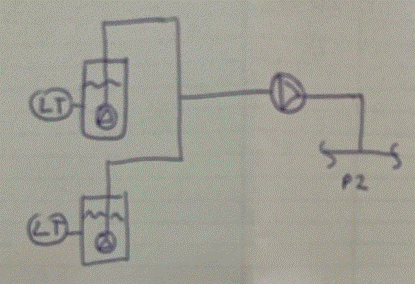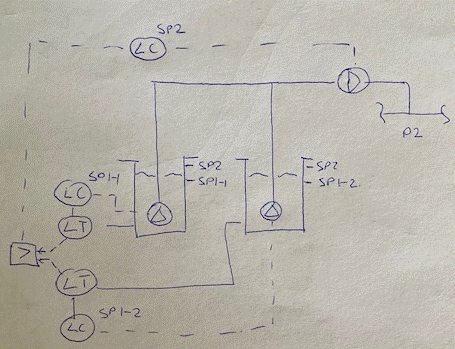Looks like you do not need a VSD at all. Flow rate is apparently constant and therefore I suspect so are pressures. The only possible reason I can see for using a VFD is if the tank pumps produce too much flow and/or pressure when running at their rated, constant speed rpm. When everything is constant, that it could indicate the tank pumps are too big and the VFD was installed to get them to run slower, but then they would not be controlling the tank level. Are? the tank pumps running with widely varying rpm now? The VFD may be keeping the level constant, but that's a bit strange, as tanks are usually installed because the flow into the tanks varies, it does go up and down, but having tanks allows you to pump out at a constant rate. In other words, if you have tanks, you should not need a VFD. Tanks are the capacitors of hydraulic systems. They turn flow variation into constant streams. Their levels are supposed to vary. If there's no flow variation, why have tanks.
Why have VSD controlling a suction tank level? All that does is make the pumps run slower and slower until you reach the control level (probably some low tank level), then the control circuit stays hot while the pump sleeps. Flow also stops when the pumps are sleeping. A LSL/LSH does the same, except the pump rpm is not slowed down before stopping and circuits are cold when the pump is stopped. Why do you have to slowly reduce pump rpm, in such a carefully controlled VSD manner? It makes even less sense to use VFD, if the flow is nearly constant.
Adding a booster does not change anything so far, just increases the discharge pressure. If the 18barg maximum discharge pressure does not overpressure P2, there is no need to control it. Again, why VFD? The only reason for a VFD booster is if the booster pump cannot run efficiently somewhere in the range of 12 to 18 barg. Then you might want to size the booster to produce 18bar at rated speed and flow, but slow the booster rpm down when you can inject into P2 at the lower range, say 12 to 15barg. If you will spend a lot of time pumping at inefficient flow rates, maybe you can save some money by using a VFD booster, or a control valve. Look at the efficiency of the pump between 12 and 15 barg. If it is notably worse, and power consumption is high, go for a VFD or CV solution. Otherwise let the booster pump run constant speed.
So far I am not convinced you need VFD anywhere and the simple level and pressure switches will work just fine. Check the energy consumption at flow rates between the 12 to 15b range and decide if its worth it. I dont see the need to control any process variable with VFD or CV, but maybe you can save some power. Neither control arrangement will start or stop flow, as long as there is enough water in the tanks. If you run out of tank water, both types of control systems have no choice but to stop.
The only thing I need to know is
Are? the tank pumps running with widely varying rpm now?
But for now it looks like the VFD is substituting for a simple HL level switch
A black swan to a turkey is a white swan to the butcher ... and to Boeing.



